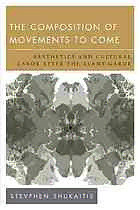
The Composition of Movements to Come: Aesthetics and Cultural Labor after the Avant-Garde PDF
Preview The Composition of Movements to Come: Aesthetics and Cultural Labor after the Avant-Garde
The Composition of Movements to Come .................18816$ $$FM 11-09-1513:46:21 PS PAGEi NewPoliticsofAutonomy SeriesEditor:SaulNewman In recent years, we have witnessed an unprecedented emergence of new forms of radical politics—from Tahrir Square, Gezi Park, and the global Occupymovement,toWikileaksandhacktivism.Whatisstrikingaboutsuch movementsistheirrejectionofleadershipstructuresandtheabsenceofpolit- ical demands and agendas. Instead, their originality lies in the autonomous formsofpoliticallifetheyengender. TheNewPoliticsofAutonomybookseriesisanattempttomakesenseofthis new terrain of antipolitical politics, and to develop an alternative conceptual and theoretical arsenal for thinking the politics of autonomy. The series investigatespolitical,economic,andethicalquestionsraisedbythisnewpar- adigm of autonomy. It brings together authors and researchers who are engaged,invarious ways,withunderstanding contemporary radicalpolitical movements and who approach the theme of autonomy from different per- spectives: political theory, philosophy, ethics, literature and art, psychoana- lytictheory,politicaleconomy,andpoliticalhistory. TitlesintheSeries SpacesofGovernmentality,byMartinaTazzioli TheCompositionofMovementstoCome,byStevphenShukaitis .................18816$ $$FM 11-09-1513:46:21 PS PAGEii The Composition of Movements to Come Aesthetics and Cultural Labor after the Avant-Garde Stevphen Shukaitis London•NewYork .................18816$ $$FM 11-09-1513:46:24 PS PAGEiii PublishedbyRowman&LittlefieldInternationalLtd UnitA,WhitacreMews,26-34StannaryStreet,LondonSE114AB www.rowmaninternational.com Rowman&LittlefieldInternationalLtd.isanaffiliateofRowman&Littlefield 4501ForbesBoulevard,Suite200,Lanham,Maryland20706,USA WithadditionalofficesinBoulder,NewYork,Toronto(Canada),andPlymouth(UK) www.rowman.com Copyright(cid:2)2016StevphenShukaitis Allrightsreserved.Nopartofthisbookmaybereproducedinanyformorbyany electronicormechanicalmeans,includinginformationstorageandretrievalsystems, withoutwrittenpermissionfromthepublisher,exceptbyareviewerwhomayquote passagesinareview. BritishLibraryCataloguinginPublicationData AcataloguerecordforthisbookisavailablefromtheBritishLibrary ISBN:HB978-1-7834-8172-9 PB978-1-7834-8173-6 LibraryofCongressCataloging-in-PublicationData Names:Shukaitis,Stevphen,author. Title:Thecompositionofmovementstocome:aestheticsandculturallaborafterthe avant-garde/StevphenShukaitis. Description:London;NewYork:Rowman&LittlefieldInternational,[2016](cid:2)Series: Newpoliticsofautonomy(cid:2)Includesbibliographicalreferencesandindex. Identifiers:LCCN2015034957(cid:2)ISBN9781783481729(cloth:alk.paper)(cid:2)ISBN 9781783481736(pbk.:alk.paper)(cid:2)ISBN9781783481743(electronic) Subjects:LCSH:Politicsandculture.(cid:2)Aesthetics—Politicalaspects.(cid:2)Communist aesthetics.(cid:2)Art—Politicalaspects.(cid:2)Criticaltheory. Classification:LCCJA75.7.S542016(cid:2)DDC306.2—dc23LCrecordavailableathttp:// lccn.loc.gov/2015034957 (cid:3)(cid:3)(cid:4) ThepaperusedinthispublicationmeetstheminimumrequirementsofAmerican NationalStandardforInformationSciences—PermanenceofPaperforPrintedLibrary Materials,ANSI/NISOZ39.48-1992. PrintedintheUnitedStatesofAmerica .................18816$ $$FM 11-09-1513:46:25 PS PAGEiv Contents Acknowledgments vii Let’sTaketheFirstBusoutofHere:AUser’sGuide ix 1 Introduction:ClassCompositionandtheAvant-Garde 1 Territories: Psychogeography 2 TheoriesMadetoDieintheWarofTime 25 3 MetropolitanStrategies,PsychogeographicInvestigations 47 Art/Work: Sabotage 4 CanCreativePracticeBreakBricks? 67 5 LearningNottoLabor 87 Institutions: Overidentification 6 FascistsasMuchasPainters 103 7 IconsofFuturesPast 121 Coda:TheCompositionofMovementstoCome 139 Bibliography 153 Index 171 AbouttheAuthor 177 v .................18816$ CNTS 11-09-1513:46:24 PS PAGEv .................18816$ CNTS 11-09-1513:46:24 PS PAGEvi Acknowledgments This book is a bringing together of work I’ve been carrying out since 2009. Thus,notsurprisingly,ithasinvolvedawholeconstellationofdialoguesand exchanges that have been integral to its development. Such discussions are notsecondarytothelaborofthoughtbutareatitscore.Acknowledgingthese debtsisdone notin hopesthattheywillbedispelled,forsomedebtsarenot meanttobepaidback,butdeepenedandextended. Thankstotheresearchinstitutesthathavehostedmeforkeypartsofdevel- opingtheideasandargumentshere,includingCenterforCulture,Place,and Politics at the City University of New York, where I was a visiting fellow in 2010(specialthankstoDavidHarveyandRuthGilmore-Wilson);theCentre for Innovation and Structural Change at the National University of Ireland, which hosted me in 2012; and Singapore Management University, which provided space and support in 2013 (many thanks to Stefano Harney for arrangingthat,alongwithmanywell-spenteveningsoverbeerandbooks). Extra thanks to my wonderful colleagues from the School of Philosophy and Art History and the Centre for Work, Organization, and Society at the University of Essex, who have had to listen to me warble on about such thingsforyears.Allofyourthoughtsandconvivialityflowthroughthebook, and without the ongoing paycheck for my academic labors I most certainly wouldnothavefinishedthis. Sections of this book have been presented at a series of conferences and seminars,withcommentsandfeedbackintegratedintothetext.Attheriskof creating an overly long list, thanks to Konrad Becker and the Institute for New Culture Technologies (Vienna), everyone at the Centre for Philosophy andPoliticalEconomyattheUniversityofLeicester,StephenDuncombeand the Gallatin School at New York University, the Centre for Contemporary Art (Glasgow), Schijnheilig Gallery (Amsterdam), Giuseppina Mecchia and French & Italian Studies Department at the University of Pittsburgh, Tony vii .................18816$ $ACK 11-09-1513:46:27 PS PAGEvii viii Acknowledgments SampsonandJeremyGilbertfromtheUniversityofEastLondon,thePoliti- cized Practice Research Group at Loughborough University, Geoff Cox and the School of Communication and Culture at Aarhus University, Auto Italia South East, Miran Mohar and the Academy of Visual Arts (Ljubljana), and Greg Seigworth and the Department of Communication at Millersville Uni- versity.Keypartsofthebookalsocomeoutofideasgeneratedforthe‘‘Truth Is Concrete’’ festival in Graz and the transmediale festival at the Haus der Kulturen der Welt in Berlin. And special thanks to everyone at the Depart- ment of Social and Critical Political Studies at Vytautas Magnus University (Lithuania),whowereblessedand/orcursedbythepresentationoftheentire bookintheformatofaseminarinspring2014. Muchthankstoalloftheauthors,artists,andpoetswhoseworkI’vefound useful and inspired, and have borrowed morethen an idea or two from. And special thanks to those who I’ve been lucky enough to get and argue about suchthingswithincludingKenWark,AlexeiMonroe,GavinGrindon,Bruno Gulli,andBrianHolmes. Much of this book comes out of ideas developed in relationship to the ongoing book series that I edit, Minor Compositions. Thanks to all of the authors whose work has been published, as the close engagement with your workhasbeenaconstantsourceofinspirationforme(aswellasanongoing sourceofepicamountsoflabor).Thankfully,theentireseriesisavailablefor freeonlineasPDFs(aswellasintraditionalprintform)andcanbefoundat http://www.minorcompositions.info. Thankstojournalsthathavegivenpermissiontorepublishpreviouslypub- lished and reworked materials, including Rethinking Marxism, Culture & Organization, Cultural Studies (cid:4)(cid:5)(cid:5) Critical Methodologies, Performance Research,andSociologicalReview. Nietzsche once said that if you have a why of life, you can put up with almost any how. Special thanks to my friends and comrades who have been so important in constantly creating and re-creating those whys, including JackBratich,Anja Kanngeiser, RichardGilman-Opalsky,JoannaFigiel,and VyvyLewis. Andlast,butcertainlynotleast,allmylovetoGustav,themostwonderful sonone couldeveraskfor.Thisbookisfor him, evenifhewon’t beableto understanditformorethanafewyears. .................18816$ $ACK 11-09-1513:46:27 PS PAGEviii Let’s Take the First Bus out of Here A User’s Guide You are holding in your hands a book on political strategy, albeit quite a strange one. ‘‘A book on strategy?,’’ you mutter to yourself. That can’t be correct.Afterflippingthroughquickly,itseemtoincludeloadsofdiscussions about various art movements, some currents of politically oriented cultural production . . . but, surely, just bringing together some pretty pictures and fancy-soundingtheorydoesn’tmakeabookonstrategy,doesit?Oddornot, thisispreciselyit:abookthatattemptstorethinkandreworkthespacewhere strategyoccursasanongoingsocializedprocess.Itisaprocessthattakesits cues from artists and dreamers rather than from generals, politicians, and other po-faced figures more commonly associated with the easier connota- tions of strategizing. To this you might raise an objection: Why even talk about strategy? Is it not the case, in the wake of the Occupy movements, the proliferation of horizontal and networked forms of social movement without top-down leadership, that strategy is an anachronistic concept, a concept that’s better left behind? I have a bone to pick with that set of assumptions. This book comes out of reflecting on a set of experiences and political encounters, starting from the rise of the antiglobalization movement in the late 1990s. During this time it became quite common, one might even say hegemonic,toarguefortheimportanceofadiversityoftacticswithinmove- mentorganizing.1Thisnotioncontinuedtospreadandverymuchhasbecome aformofactivistcommonsense.Thelogicofembracingadiversityoftactics allowedforthemoreconfrontationalapproachesinprotestswithmorelegally acceptable and permitted ones. In certain waysthis is quite logical, as it can bequitesensibleto wantto createapluralformofantagonistic politicssuch ix .................18816$ PREF 11-09-1513:46:29 PS PAGEix
